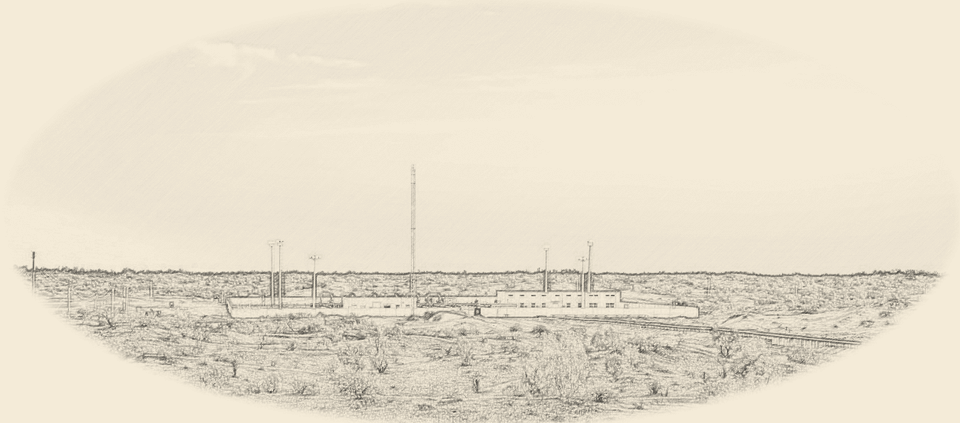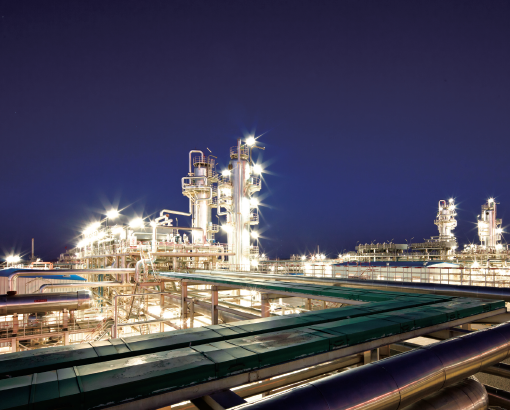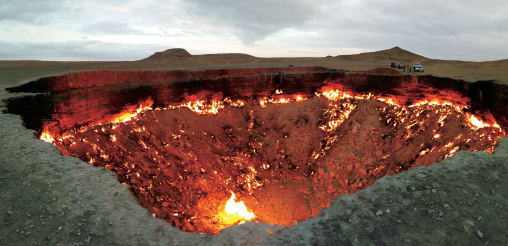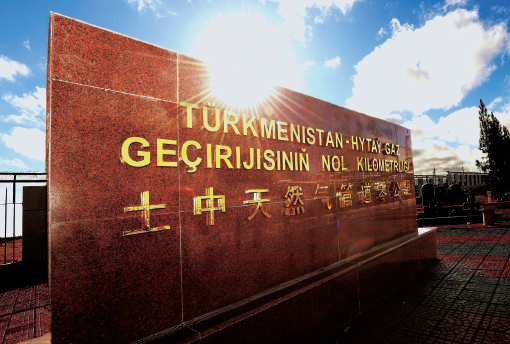Central Asia's Rainbow of Hope
By Ma Li Wenbo
[Turkmenistan] Nurmamedov Yusup Rustamovich
In Derweze, a village in Turkmenistan's Karakum Desert, a tourist recently asked the locals how to get to the "Gates of Hell", an enormous crater that has been on fire for decades and a unique tourist attraction in the region.

"I'm sorry, the 'Gates of Hell' has been closed. Now we only know the 'Land of Happiness'," a local resident replied proudly.

The No.1 gas processing plant, the main first phase project, on the right bank of the Amu Darya River
The "Land of Happiness" is the name given to the gas field on the right bank of the Amu Darya River, the source of gas for the Central Asia-China Gas Pipeline Project.
“Land of Happiness”
Turkmenistan has the fourth highest volume of gas reserves in the world. For a long time, gas was free in the landlocked nation and there were people who never switched off their stoves even when not cooking in order to save matches.
Turkmenistan's gas fields are characterized by high pressure, high yield, high temperature, and high sulfur, carbon dioxide and mineralized water contents. So it was a world-class challenge to develop them. Some people vividly compared drilling wells in Turkmenistan to "dancing on the tip of a knife or singing in the flame". Therefore, for a long time, despite the huge gas reserves it was difficult to convert the resource advantage into development advantage. Before a Chinese company successfully explored and developed the Amu Darya right bank gas project, the area had seen a meager 29.9 percent success rate in drilling and was considered a drilling exclusion zone.
The "Gates of Hell", a burning gas crater 69 m in diameter and 30 m deep, has the temperature in its pit reaching 1,000 degrees Celsius. It has been burning for over 48 years since it was formed, burning up natural gas worth USD1 billion every year. The unique tourist attraction is actually a huge scar created by a drilling blowout accident. There are also fire pits, water pits and sinkholes of other kinds on the right bank of the Amu Darya, created by failed exploring efforts. These spectacular sinkholes are perfect evidence of the difficult history of gas development here.

The "Gates of Hell" in Turkmenistan
However, the "Gates of Hell" would not roar forever, nor would the drilling exclusion zone remain unconquerable. Consultations and joint efforts by the governments of China, Kazakhstan, Uzbekistan and Turkmenistan have resulted in the official signing of crossborder gas pipeline projects, activating Turkmenistan's gas fields, and creating enormous value for countries along the pipelines.
The first phase of the Galkynysh gas field in southeast Turkmenistan and the second phase of the Amu Darya right bank gas field have been completed and put into operation successively by China National Petroleum Corporation (CNPC), the project contractor. As a result, Turkmenistan can now simultaneously supply gas from the Amu Darya gas field, Galkynysh and a third, Mary-Uchaji. The Central Asia-China Gas Pipeline Project has three lines. After Line A became operational, Lines B and C have been built and become operational as well. The arrival of the Chinese builders has completely changed the drilling exclusion zone, and the drilling success rate has gone up to 100 percent.

The Turkmenistan-China Gas Pipeline Zero-Kilometer Monument
Subsequently, Turkmen President Gurbanguly Berdymukhamedov christened the contract area on the right bank of the Amu Darya the "Land of Happiness". The Central Asia-China Gas Pipeline Project has opened up export and sales channels for Turkmenistan's gas. Natural gas from the "Land of Happiness" is transported through Uzbekistan and Kazakhstan via the pipelines and enters China, providing clean fuel for 500 million people along the routes. Through cooperation with China, Central Asian countries have entered the huge Chinese energy market and have earned more than USD40 billion in foreign exchange revenue. Driven by the natural gas trade, the China-Turkmenistan trade volume has increased more than 1,800-fold since the two countries established diplomatic relations.China has been Turkmenistan's largest trading partner for eight consecutive years.
To commemorate the operation of the Central Asia-China gas pipelines, Turkmenistan began marking December 14 as the Day of Oil and Gas Industry and Geology Workers from 2010, in a tribute to the day the previous year when the pipelines became operational.
Amazing Speed
"I didn't expect the processing plant to be built so quickly. With so many facilities built in just over a year, the amount of work you have done is huge, and the difficulties you have overcome are unimaginable. Thank you very much, diligent builders of CNPC!"
This was what President Berdymukhamedov said to the Chinese oil workers on the eve of the completion of the project, when he made a special trip to inspect the Amu Darya project's No.1 gas processing plant.
The president's words were not just a compliment.
When the project started, the Chinese builders faced unimaginably harsh natural conditions. "There were no vehicles, no communication devices, no interpreters and no logistics," someone recalled.
The biggest challenge was yet to come. In order to ensure the pipelines become operational on schedule, a number of projects had to be completed within 18 months to realize a production capacity of 5 billion cu m. They included building 28 well fields, laying 90 km of gathering and transmission pipelines and building the No.1 gas processing plant.
In a natural environment where the temperature can be as high as 50 degrees Celsius in summer and as low as minus 30 degrees Celsius in winter, this seemed to be a mission impossible.
But the Chinese workers were not daunted.
CNPC's technical team revived the Samandepe gas field on the bank of the Amu Darya, which had been shut down and sealed in 1993, in just 98 days. Using technological innovation and dedication, the workers doubled the pipeline welding speed and carried out construction smoothly despite the temperature going down to minus 40 degrees Celsius.
In this way, the Chinese company not only completed the task in time, but also set eight new drilling records in Turkmenistan. The fastest speed was drilling a well in just 34 days.
Finally, in the barren desert, the Chinese builders constructed a natural gas pipeline system from scratch. According to calculations, the volume of the materials transported for the project was equivalent to 15 years' unloading volume at the Amu Darya right bank railway station.
The completion of the pipelines has greatly increased Turkmen- istan's gas export capacity and brought great benefits to its people. Thanks to the Central Asia-China gas pipelines, Turkmenistan's gas exports have been rising continuously, and its gas production has bounced back to 80 percent of the peak level in the 1980s.
Bonded by the Belt and Road
Ensuring a good life for the people means going beyond the economy.
The gas pipelines have produced benefits that are both economic and emotional, such as love, affection and friendship.
Yidai and Yilu are mixed-race twin brothers. Yidai means "one belt" in Chinese and Yilu "one road". The elder, Chen Yidai, has black hair and black eyes and looks like his Chinese dad; the younger, Chen Yilu, has blond hair and blue eyes and resembles his mother, who is of Russian ethnicity.
Their parents met and fell in love thanks to the gas pipeline project. Dad Chen Kuan is a chef at the staff canteen of CNPC's gas compressor station in northern Uzbekistan; mom Azafiya is a server at the staff cafeteria.
The construction of the gas pipelines has not only connected the natural gas supplies of their respective countries, but also created a chance for the two young people to fall in love, which resulted in a transnational marriage.
When the twins were born, the parents named them Yidai and Yilu in the hope that the kids will emulate the close ties and sincere cooperation between different countries, love each other and be happy together.
There are many other stories about emotional bonds created by the project. The story of the "Li family" is another well-known one.

Yidai and Yilu and their parents
It's about a group of colleagues most of whom work at the Amu Darya gas processing plants and are known as the Li family. But they are all Turkmens.
For example, the actual name of Li Gaoshan, deputy director of the No.1 gas processing plant, is Yusup. He speaks not just Chinese fluently but a dialect, the Sichuan dialect spoken in southwest China. Spoken with a Turkmen accent, it often makes his Chinese colleagues laugh.
The deputy director of the No.2 gas processing plant also has a Chinese name, Li Dahai, though he is also a native of Turkmenistan.
They are called the Li family because all of them were trained by Li Gaochao, the Chinese chief engineer of the gas production process at the Amu Darya River Gas Company.
Master Li's expertise made everyone admire him. He had high hopes for his foreign mentees, teaching them all that his experience had taught him, from how to inspect instruments and meters to how to operate various types of equipment, from normal production to emergency response, and from gas production to running the purification equipment.
At present, all the 138 group leaders of the Amu Darya project production line are Turkmen technicians. They have now become the mentors, training a large number of Turkmen apprentices.
Over the years, CNPC's Amu Darya River Gas Company has trained more than 8,200 local employees, and more than 100 local employees have become part of the company's middle-level management.
The challenging engineering project has developed not only facilities but also technology, talent and of course, cultural exchanges, as well as all the wonderful things that come with such exchanges.
"The challenge of this project is not only technical difficulties, but also cultural exchange. In spite of cultural differences, we share the same human nature and the same goal of building the pipelines," a German manager involved in the pipeline construction commented.
The pipelines connecting Central Asia and China are like a brilliant rainbow of hope.
With the extension of the pipelines, the friendship of the peoples along the routes is also growing, creating a road of happiness.
FOR MORE
Project Overview
The Central Asia-China Gas Pipeline Project, jointly built and run by Sino-Pipeline International Company Limited and the countries along the routes, consists of three lines, A, B and C.
The project has increased tax revenue for the countries it runs through, driven the growth of construction, oil services, pipeline operation businesses, various service providers, suppliers and other industries in these countries, and created considerable economic benefits. The gas pipelines have not only promoted oil and gas cooperation between China and other countries in the region but also the economy and trade in other fields.
As of the end of 2019, the project had provided more than 2,400 long-term jobs for the countries along the routes, and created more than 20,000 temporary jobs during the peak construction period. Sino-Pipeline International also engages in public welfare undertakings and has improved the infrastructure of the communities along the routes. The company pays close attention to the impact of the pipeline construction and operation, and is working out effective measures with the construction companies, supervision companies and communities along the lines to jointly protect the environment.


